My friend Personal Demon recently forwarded me an article that deals with a rather cute idea: Photorealistic ray tracing aids understanding of metamaterials. “Metamaterials” may be described roughly as materials with a man-made structure on the scale of nanometers which gives them unusual optical properties not to be found in nature. With that in mind, the rest of the article title, though rather technical-sounding, simply refers to computer simulations which can answer the following question:
Suppose you have constructed a piece of metamaterial of “everyday” size. What does it ‘look’ like to the unaided human eye?
This to me is an interesting question for a number of reasons. For one, it is not yet within our power to construct metamaterials which are larger than microscopic size (though, as I’ve noted previously, we’re getting closer). Being able to simulate the materials gives us a head-start in developing possible applications. Second, we already know that metamaterials have the potential to produce interesting visual effects — including, possibly, invisibility! Finally, it can be very difficult, and intellectually stimulating, to try and make the connection between what light is doing in an optical system and how the system would appear to a person looking at it.
It’s worth taking a moment to describe the idea of negative refraction, which is the effect most associated with metamaterials. When light travels in an ordinary material medium, it is typically slowed down. The amount of slowing depends upon the properties of the material, and the fraction by which the speed of light is reduced is referred to as the refractive index. For visible light, water has an index roughly
, while crown glass, used to make lenses, has an index roughly
. It is important to note, however, that the definition of the velocity of light in matter is rather tricky, as the material properties depend on the frequency of light. We neglect such complications in this discussion and treat the refractive index as the amount of ‘slowing’ the light experiences.
Light passing from air into an ordinary material such as water are therefore slowed down; experiment, and later theoretical calculations, show that the light ray is bent as it passes into the new material, a process called refraction:
The angles and
which the incident and transmitted light rays respectively make with the normal to the surface satisfy Snell’s law:
.
It is not immediately obvious how refraction affects the appearance of objects, but a little experimentation gives us the right idea:
The photo shows how refraction effects the image of a straw submerged in a glass of tasty green tea ginger ale; the red lines have been added to show how the straw appears to bend at the air-ale interface.
Up until recently, it had been assumed that the refractive index of a material is always positive. In the 1960s, a Russian scientist named Vesalago1 suggested that a negative refractive index might be possible and he investigated theoretically what would happen if a material had a negative refractive index. Among the possible effects suggested were negative refraction, negative Doppler shift (which we won’t discuss here), and planar focusing.
Snell’s law is still satisfied when one of the materials has a negative refractive index, but the direction of the light ray is ‘mirror-imaged’ about the normal to the surface:
Veselago pointed out that a planar sheet of material with negative refractive index could be used as a lens, if of the proper thickness and material parameter:
Veselago’s original paper seems to have initially gotten little attention. This is not surprising, as material science had not progressed far enough for the construction of negative materials to be feasible. In 2000, however, J.B. Pendry suggested2 that a slab of negative material could not only be used as a lens, but as a ‘perfect’ lens! Ordinary imaging systems cannot resolve objects separated less than a wavelength apart, but a negative material could in principle compensate for this loss of resolution and produce a perfect point image (though in practice there would still be limits to resolution). Pendry’s paper created a storm of controversy and effectively brought the study of metamaterials into the mainstream of physics. The time was right, as researchers have reached the point where manipulating the structure of materials on small scales is becoming gradually easier.
Putting the ‘perfect imaging’ question aside, we now turn back to the question: what would a negative refractive index material look like? We cannot, as yet, construct a metamaterial large enough to produce interesting optical effects to the naked eye, but we can do computer simulations to analyze what such materials might look like. Snell’s law can be used to describe most visible phenomenon, which means light can be treated as a collection of rays: the computational technique used for modeling is known as ‘ray tracing’. Professor Aaron Danner of the National University of Singapore (with acknowledgement to D. S. Hanggoro for computer artwork) produced images showing the difference between the appearance of a swimming pool filled with regular water, , and a pool filled with ‘negative water’ with index
. First, the image of a pool filled with regular water (from the original article):
Now, compare this image with the appearance of an Olympic swimming pool filled with ‘negative water’:
Notice the difference? The three thin intersecting lines seen in the water near the bottom of the photo is the image of the bottom corner of the pool. Because of the way light bends when negatively refracted, one can effectively “see around corners”:
The fish in the picture would be blocked from direct view by the wall of the pool, but light reflected off the fish is negatively refracted at the air-‘negative water’ interface and reaches the eye of the observer.
Simulations such as these provide interesting insight into the physical properties of unusual materials. I suspect that there are a number of intriguing optical effects one could deduce from just a few images of negative materials such as these.
As I noted previously, it is often a non-trivial exercise to go from the understanding of an optical effect to the understanding of what that effect would look like. To draw from work I am personally acquainted with, in 2002 researchers demonstrated3 that rapid changes in the spectrum of focused light (previously referred to as ‘spectral switches’) could be associated with so-called ‘phase singularities’ of wavefields, points at which the intensity of the field vanishes and the phase takes on very odd behaviors (more on this in an upcoming post). This research itself received a lot of attention, but later in the same year, Professor Michael Berry (known best for the so-called “Berry phase,” though it is not called that by him) published a pair of papers4,5 in which he asked: suppose one could amplify the light in the neighborhood of one of these dark regions where the spectrum changes rapidly. What would the result look like to the naked eye? To answer this question, Berry needed to delve into the workings of the human eye and understand how it responds to color, and then simulate the effect. For the record, the colors appear as follows (from the paper “Coloured phase singularities”, which is free to read online):
The different rows of pictures represent different blackbody sources of light, while the two columns represent the image at two different magnifications.
Still interested in more puzzles related to physics and seeing? Here are a few tricky questions to try and answer; if people are interested (and I can figure them out myself), maybe I’ll post answers later:
- A phase-conjugate mirror is a mirror which sends light rays incident upon it directly back in the direction from which they came (via a nonlinear optical effect). What would you see if you looked into a phase-conjugate mirror?
- Suppose you were an astronaut, floating weightless in the dark with your head in the center of a giant (say, roughly house-sized) reflecting sphere. When you turn on your flashlight, what do you see? (Borrowed from one of Spider Robinson’s books on Callahan’s Crosstime Saloon.)
- One can make a cylindrical mirror by taking a highly reflective metal sheet and bending it into a semi-cylindrical shape. When the concave part of the mirror is facing you, and the semi-cylinder is horizontal, you will see an inverted image of yourself in the mirror. What happens to your image when you rotate the cylinder from horizontal to vertical? (Paraphrased from the excellent book by Jargodzki and Potter, Mad About Physics.)
- Looking back at the image of the straw in the glass, the straw appears bent in the image through the top surface of the water, but the image through the side of the glass is parallel to the unsubmerged bit. Why the difference?
Have fun!
********************************
1V.G. Veselago (1968), “The electrodynamics of substances with simultaneously negative values of ε and μ,” Sov. Phys. Usp. 10 (4) (1968), 509–14.
2J.B. Pendry, “Negative refraction makes a perfect lens,” Phys. Rev. Lett. 85 (2000), 3966.
3G. Gbur, T.D. Visser and E. Wolf, “Anomalous behavior of spectra near phase singularities of focused waves”, Phys. Rev. Lett. 88 (2002), 013901.
4M.V. Berry, ‘Coloured phase singularities’, New Journal of Physics, 4 (2002), 66.1-66.14.
5M.V. Berry, ‘Exploring the colours of dark light’, New Journal of Physics, 4 (2002), 74.1-74.14.

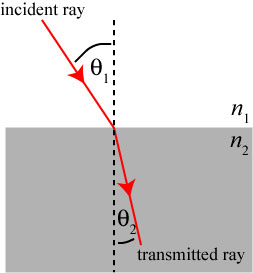
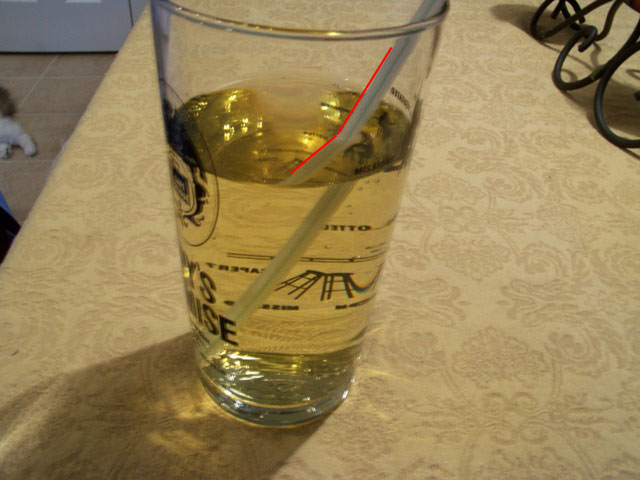

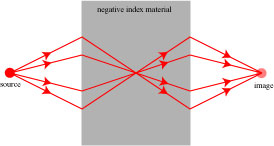

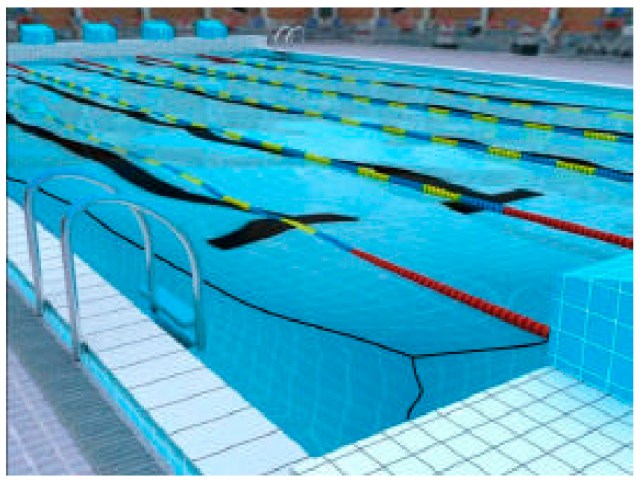
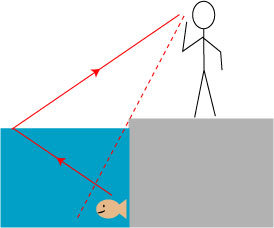


Great explanation of negative-index materials — I hadn’t seen those ray-tracing pictures before, which really help clarify what those materials would look like. The “looking around the corner” aspect is especially interesting.
Back when metamaterials first started getting reported on, I was disappointed to find out that they only worked at a specific frequency (due to the periodic structures that give the negative-index effects). This sounds like it precludes a real negative-index material like the “negative water” shown above, which works over the whole range of visible light. Have you heard of any way to overcome this problem?
hi , i am trying to locate an image of actual refraction , photon striking h20 , = blue , violet , red , is it possible to see such an image ? many thanks , bill
So what would you see if you looked into a phase conjugate mirror?
As I understand it, you would see: pretty much nothing! In order to see an object, light has to reflect off of that object and then enter your eye. When you look into a regular mirror, you see the light has has come from an object, reflected off of the mirror and then into your eye. However, a phase conjugate mirror sends every photon (light particle) back the way it came — the only photons that would reach your eye via the mirror would be those that originally came from your eye, which would be pretty much nothing!
I’m having a great time reviewing these old posts!
I came to the same conclusion as you did about phase-conjugate mirrors, and it made me wonder whether phase-conjugate mirrors might be an interesting way to study a detector using the detector itself… for example studying your own retina using your own retina, which is tricky because of the constant variation in fluid thickness on the eye. I see that eliminating double-pass wavefront aberrations is, indeed, one of the primary applications of phase-conjugate mirrors. (No Nobel Prize for me!)
It seems like there must be *something* else one can use phase-conjugation for — perhaps using it to study the detector itself would be a useful application. I’ll have to give that some more thought…
Pingback: Reversing optical “shockwaves” using metamaterials (updated) | Skulls in the Stars
Pingback: Some musings on negative refraction | Skulls in the Stars
Pingback: Metamaterials: Soundproofing The Future - Resonics Blog
Hello,nice share.
Pingback: অদৃশ্য হওয়ার প্রযুক্তি: কল্পনা বনাম বাস্তবতা – Banglanews247
I know this is a decade old post, but what would a photo look like if the lens of the camera was made of this material?
Pingback: Exploring the ingenious science and science fiction of making things invisible – Techscurry.com – High Quality Tech News Without Distractions.